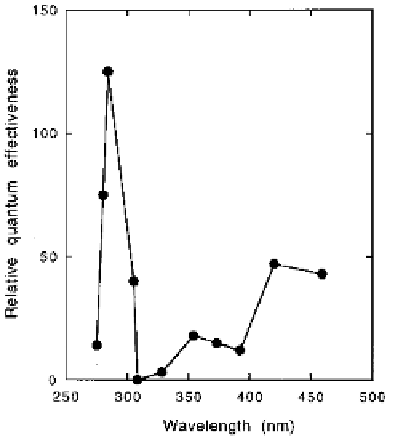Environmental Engineering Reference
In-Depth Information
involved. The B response is driven by a B absorbing photoreceptor (BAP) with action
maxima at 420, 450 and 470 nm
57
, and the R response is driven by photosynthesis
alone
58-60
.
Relatively little attention has been paid to the UV waveband with respect to
stomatal opening. It has been reported that UV-A radiation causes stomatal opening in
broad bean
61
and Teramura et al
62
reported reduced stomatal resistance in cucumber in
response to UV-B radiation in long-term experiments. Generally, the action of UV-B
radiation has been to cause stomatal closure
63-66
; however, these responses are probably
caused by the relatively high fluence rates of UV-B used and the consequent damaging
effect on membrane permeability
67
. Nogués et al
68
demonstrated decreasing stomatal
conductance with increasing UV-B irradiance in three different species.
There appears to have been only one true action spectrum carried out to study the
relative effectiveness of the UV wavelengths in inducing stomatal opening. In a study of
broad bean epidermal strips, Eisinger et al
69
found a major peak near 280 nm (284 nm)
and subsidiary peaks near 350 and 450 nm (Fig. 4). It is important to note that low
fluences were used by Eisinger et al
69
; relatively high fluence rates of UV-B radiation
(ca. 2 µmol m
-2
s
-1
over one hour) tend to result in stomatal closure
64
. Eisinger et al
found that adding low fluence rate 280 nm radiation to saturating R light caused
additional stomatal opening whereas addition of 280 nm radiation to saturating B light
did not. From this observation, and evidence in the literature, the authors conclude that
rather than a specific UV-B photoreceptor being involved, the UV-B and B
photoreceptors are synonymous and that the 280 nm response results from energy being
transferred to the chromophore of the BAP from the protein moiety of the
protein-pigment complex.
Figure 4
. Action spectrum for the induction of stomatal opening in broad bean epidermal strips.
Samples were exposed to monochromatic radiation for one hour. Redrawn after Eisinger et al
69
.

Search WWH ::

Custom Search